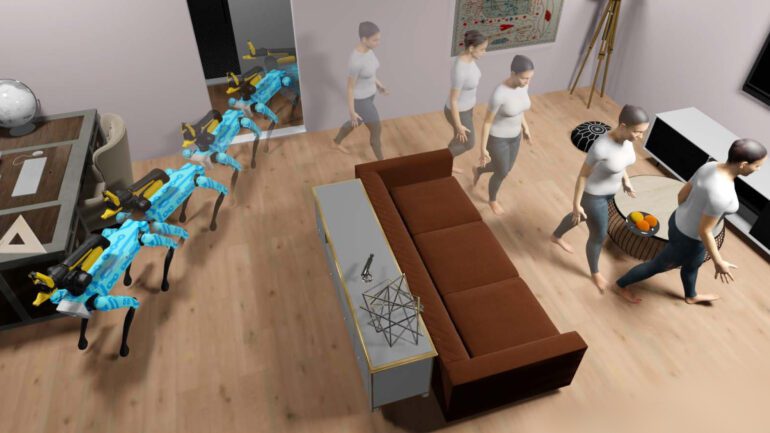TL;DR:
- Meta AI’s FAIR division focuses on socially intelligent robotics.
- Goal: Develop robots for everyday tasks, enhancing quality of life.
- FAIR’s approach blends AI, AR, VR, and robotics.
- Three key advancements: Habitat 3.0, HSSD-200, and HomeRobot.
- Habitat 3.0: High-quality simulator for human-robot collaboration.
- HSSD-200: Synthetic 3D dataset for efficient robot training.
- HomeRobot: Shared platform for mobile manipulation tasks.
- Embodied AI for dynamic human-robot interactions.
- Training AI models in simulation for real-world deployment.
Main AI News:
In the realm of cutting-edge robotics, Facebook AI Research (FAIR) is at the forefront, dedicated to propelling the field of socially intelligent robotics to new heights. Their primary mission? To develop robots with the capacity to seamlessly assist with everyday tasks, all while intuitively adapting to the unique preferences of their human counterparts. This ambitious endeavor takes FAIR deep into the intricate world of embedded systems, setting the stage for the next generation of Augmented Reality (AR) and Virtual Reality (VR) experiences. The ultimate goal to seamlessly integrate robotics into our daily lives, relieving us of mundane chores and elevating our overall quality of life. FAIR’s multidimensional strategy underscores the critical fusion of Artificial Intelligence (AI), AR, VR, and robotics, painting a vision of a future where technology effortlessly enhances our daily existence in unimaginable ways.
To overcome the challenges of scalability and safety in the training and testing of AI agents within physical environments, FAIR has engineered three groundbreaking advancements:
- Habitat 3.0: This high-fidelity simulator emerges as a cornerstone for robotics research, providing a controlled and secure environment for algorithm testing within virtual realms. Habitat 3.0 serves as the stage for human-robot collaborations, replicating home-like scenarios. With lifelike humanoid avatars, it becomes a training ground for AI, offering benchmark tasks that promote cooperative behaviors between robots and humans in real indoor situations, such as cleaning and navigation. In essence, it opens new frontiers in the exploration of socially embedded AI.
- The Habitat Synthetic Scenes Dataset (HSSD-200): Crafted by skilled artists, this 3D dataset revolutionizes the training of navigation agents in simulated environments. Comprising 211 meticulously designed 3D scenes that mimic physical interiors, it boasts a repository of 18,656 models spanning 466 semantic categories. Despite its smaller scale, ObjectGoal navigation agents trained on HSSD-200 exhibit performance levels on par with those trained on significantly larger datasets. In some instances, training on a mere 122 HSSD-200 scenes outperforms agents trained on 10,000 scenes from previous datasets, demonstrating its remarkable efficiency in generalizing to real-world scenarios.
- HomeRobot Platform: Addressing the necessity for a shared platform in the realm of robotics research, HomeRobot emerges as a game-changer. It defines motivating tasks, provides versatile software interfaces, and fosters community engagement. At its core, open-vocabulary mobile manipulation stands as a formidable challenge, pushing robots to manipulate objects in diverse environments. The HomeRobot library supports navigation and manipulation for Hello Robot’s Stretch and Boston Dynamics’ Spot, both in simulated and real-world settings, thus promoting the replication of experiments. The platform underscores transferability, modularity, and baseline agents, culminating in a benchmark that showcases a remarkable 20% success rate in physical-world trials.
In the ever-evolving field of Embodied AI research, the focus transcends static scenarios. Facebook AI envisions socially intelligent robots that excel in dynamic settings, characterized by collaboration, communication, and the ability to predict future states. To realize this vision, researchers harness the power of Habitat 3.0 and HSSD-200 as indispensable tools to train AI models within simulation environments. The ultimate aim is to empower these models to adapt to human preferences and, subsequently, deploy them in the real world to assess their real-world performance and capabilities. This journey represents a pivotal step towards the integration of social embodied AI agents into our daily lives, setting the stage for a future where humans and robots work together seamlessly, transforming the way we live and interact.
Conclusion:
Meta AI’s innovations are poised to reshape the market by ushering in a new era of socially intelligent robotics. These breakthroughs promise to make robotics an integral part of our daily lives, with applications in diverse fields. The combination of cutting-edge simulation tools, high-quality datasets, and versatile platforms paves the way for more efficient and adaptable AI-driven robotics, driving growth and innovation across industries.

